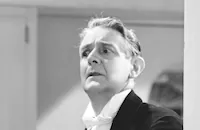King of the Jungle
Cast & Crew
H. Bruce Humberstone
Buster Crabbe
Frances Dee
Sidney Toler
Nydia Westman
Robert Barrat
Film Details
Technical Specs

Synopsis
In Africa, John and Edith Knolls take their little boy into lion country for a photographic expedition, but both parents are killed by lions. The precocious boy keeps his father's hunting knife and is reared by lions as if he were their own cub. Years later, he is able to communicate with the lions by roaring. When the young man helps the lions raid a cattle ranch, he is caught and sold to an American circus along with his lion family. Neil Forbes, the manager of the circus, names the young man Kaspa, and has him shipped to San Francisco. Upon docking, Kaspa, wearing only a leopard skin, dives into the bay. When he finally swims ashore, he is chased through a park and into a private home, where he startles Ann Rogers and her roommate, Sue. The police arrive and Ann accompanies Kaspa back to the circus, where she is invited to travel with the circus to educate him. As they become better acquainted, Kaspa and Ann fall in love. After Gus, a member of the circus, taunts a lion, he loses his arm and later plots to kill the animal. Kaspa quits the circus because he wants to return the animals to Africa, but in the meantime, Gus gives poisoned meat to the lion who mauled him. Forbes catches him, and in the ensuing struggle, a lamp falls over and the tent catches fire. After Gus is arrested, the whole circus goes up in flames, causing a panic, but Kaspa rushes in and saves the lions. He then returns to Africa with Ann, and together they set the lions free.

Cast

Buster Crabbe

Frances Dee

Sidney Toler
Nydia Westman

Robert Barrat

Irving Pichel

Douglas Dumbrille
Sam Baker
Patricia Farley
Ronnie Cosbey
Robert Adair
Florence Britton

Leonard Carey
Warner Richmond
William J. Kelly
Mabel Stark
Thomas Amos
William Dunn
Harold Farley
George Turner
Sam Farrell
F. M. Pitts
Crew

Film Details
Technical Specs

Quotes
Trivia
Notes
The working title of the film was The Lion's Way. Larry "Buster" Crabbe, the 1932 Olympic gold medalist swimmer, made his starring debut in this film. A Hollywood Reporter news item noted that USC football player Orv Muller tested for the lead, and also noted that "Paramount's boot black, Oscar" was included among a cast of six hundred extras. Hollywood Reporter production charts credit Douglas Doty, Vincent Lawrence, Cyril Hume and Jules White with contributing to the screenplay, however, their contribution to the final film has not been determined. Although the film's pressbook and reviews list Robert Adair's character as "John C. Knolls," the name "James C. Knolls" is seen on a hunting certificate in the opening of the film. The pressbook noted that animal trainer Mabel Stark handled the "cats" and appeared in the film, and animal authority Jules White also assisted in the film. News items in Hollywood Reporter note that stampeding elephants injured several stunt men during production, and that Crabbe was bitten on the leg by a tiger, but did not suffer serious injury. Information in the Jack Mintz Collection at the AFI library indicates that some scenes were shot on location in Mexico, and in Chatsworth, Santa Catalina Island, San Pedro, Laguna and San Francisco, CA. According to modern sources, Max Baer was considered for the role of "Kaspa."













